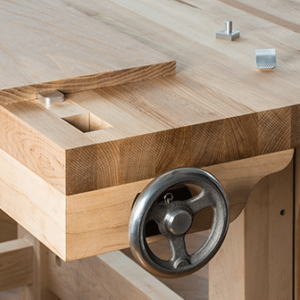History of the Wagon Vise
The wagon vise is also known as an enclosed tail vise. Traditional tail or end vises are typically mounted on the front right corner of the bench and the earliest known record of them is from the early 16th century. Tail vises are characterized by a jaw operated by a single screw, enclosed by the jaw and threaded into an end cap mounted to the bench. The vise jaw was allowed to slide by means of two wooden runners in the front and back. Construction of this type of vise was quite complicated. Later improvements used metal sliding hardware to make construction easier and operation smoother. These types of vises could hold work in a few different ways. The work piece could be held between dogs on the top of the bench. Additionally the work could also be held between the end of the movable jaw and the bench top.
The biggest issue with traditional tail vises is that the work must span the gap created between the vise jaw and the bench. This may not pose a problem if the work is of substantial thickness but if you need to work thinner material the lack of support may prove troublesome. Another issue with traditional tail vises is that they are mounted to the front edge of the bench top and are prone to misalignment and are not designed to support any significant weight.
To solve these issues the vise jaw was enclosed creating an enclosed tail vise or wagon vise. I am not certain where the wagon vise terminology began. The vise jaw, or dog block, rides in a cavity at the front of the bench and a screw threaded through the end cap of the bench creates the clamping force. In some wagon vises the screw threads in and out of the end cap of the bench top as the vise is operated. This can create a bit of an obstacle on the end of the bench. In another variation of the wagon vise the vise screw is threaded into the dog block and held stationary at the bench end cap thus eliminating the screw from extending out from the bench end cap.
Advantages of the Wagon Vise
The biggest advantage to the wagon vise is the good support and strength provided by the front rail of the bench. Since the front rail is secured to the end cap of the bench it allows for some weight bearing. The simpler design also is less prone to misalignment.
Disadvantages of the Wagon Vise
The wagon vise does not have an open gap at the front edge of the bench that can be used for additional clamping like the traditional tail vise or end vise. Work may be clamped however between the dog block and the bench if it fits within the gap created for the dog block.
The VX20W Wagon Vise
The Hovarter Custom wagon vise mechanism is the only quick action wagon vise mechanism on the market. It utilizes a hardened steel smooth clamp shaft instead of a threaded rod like other wagon vise hardware. When unclamped the dog block may quickly and effortlessly be slid in and out to suit the length of the work that needs to be clamped. Once the vise dog is placed against the work a quick turn of the clamp handle locks the vise tightly. You can apply as much or as little force just like a traditional screw. You may also clamp work between the dog block and the bench if needed.
Installation of the VX20W could not be simpler. Just create a cavity in the bench top to accept the mechanism and mount the rear bearing to the bench top. A bearing mounted to the front of the end cap supports the front of the clamp shaft. The VX20W can be outfitted with a metal hand wheel or a more traditional wooden hub and tommy bar style handle. You may also construct a handle of your own design to really give your vise and work bench the total custom treatment.[/vc_column_text][/vc_column][/vc_row]

